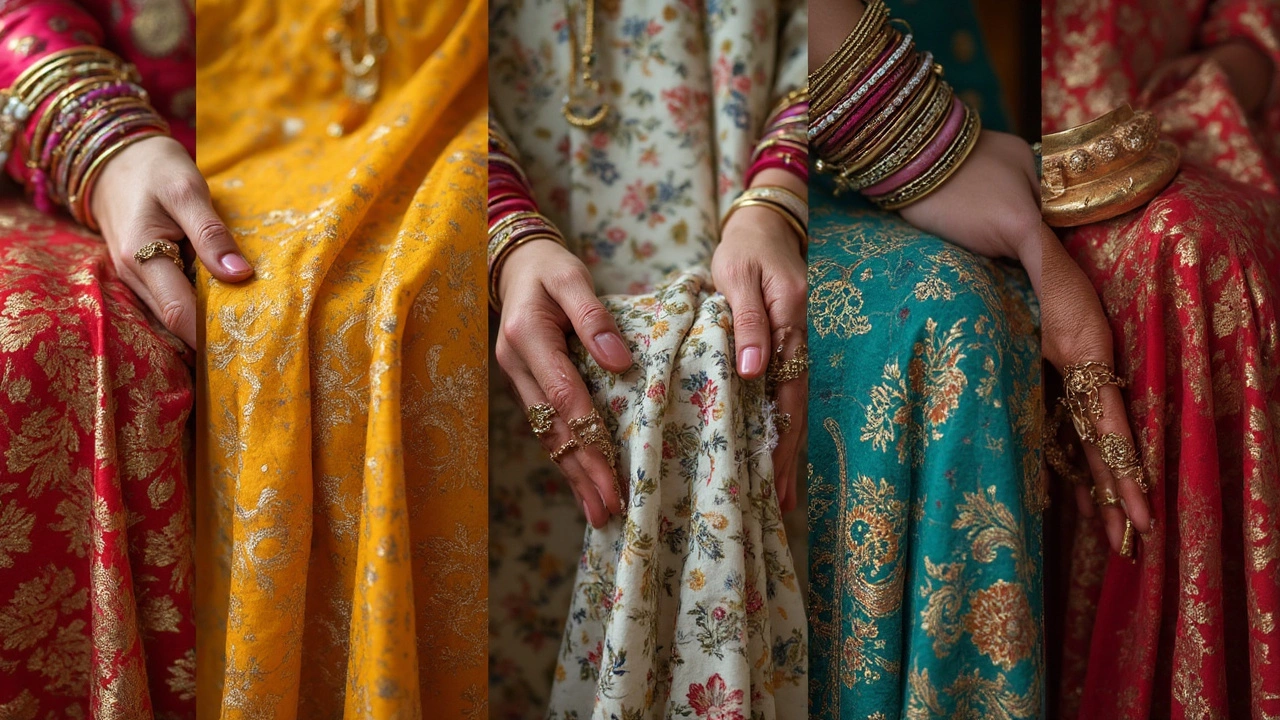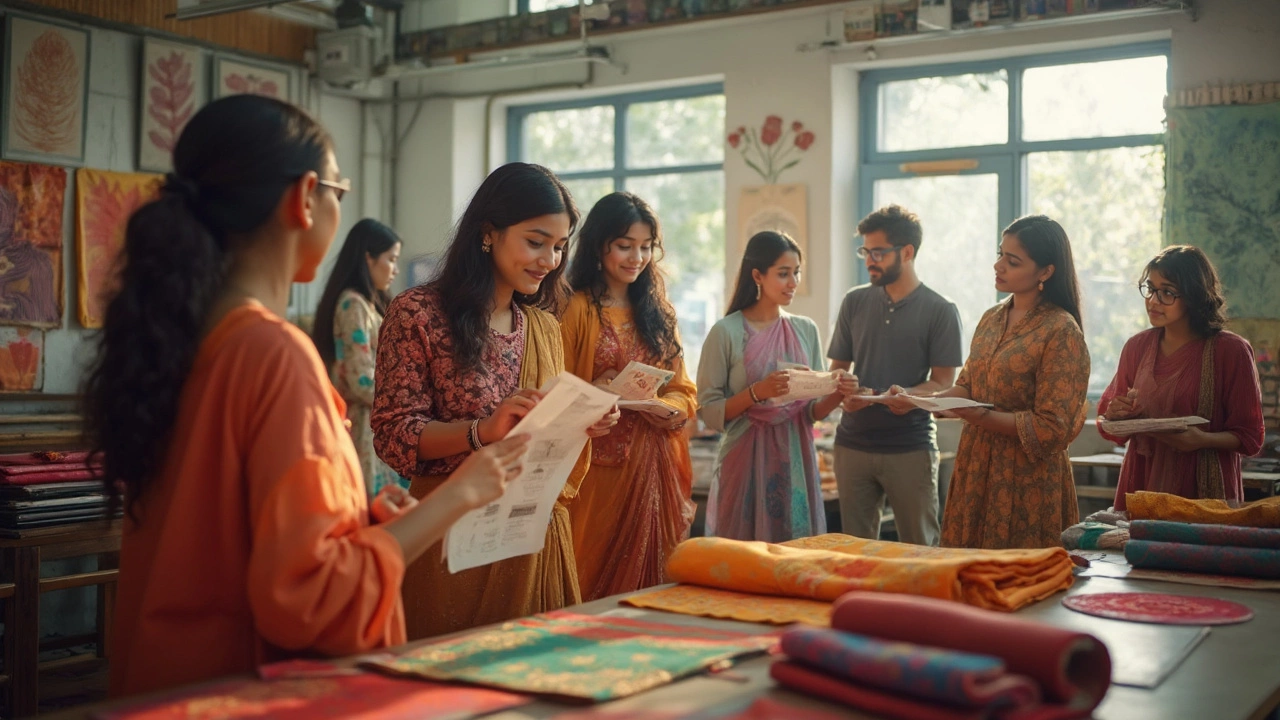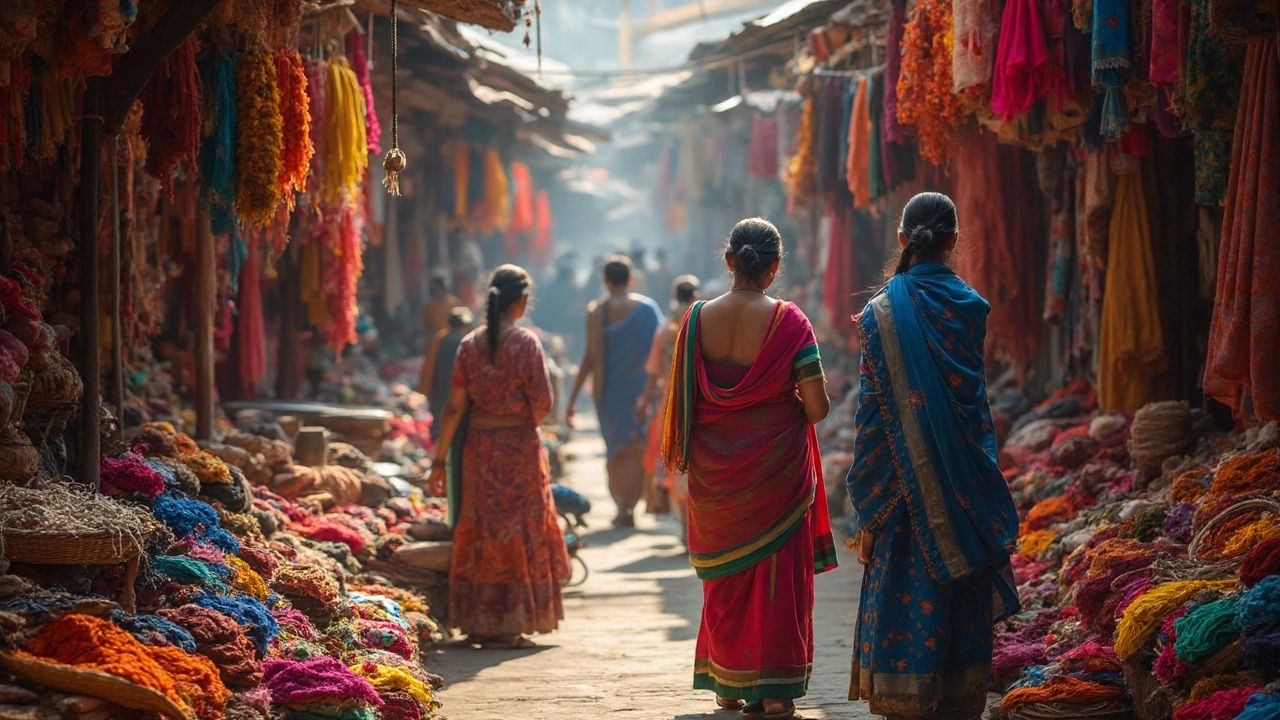If you try picking just one famous textile from India, you're in for a tough time. The country is a giant playground for fabrics—from butter-soft cottons in Gujarat to glossy silks in Karnataka. It’s not just old legends; step into a modern Indian textile market, and you’ll see everyone from big brands to local sellers banking on these famous fabrics. Why do these textiles keep turning heads? They blend history, skill, and raw material in ways you don’t see anywhere else.
Shopping for Indian textiles isn’t just about picking what looks good. You’re also making choices about durability, quality, and sometimes, even supporting local communities. Want to know what’s really famous, how to spot the difference, and why manufacturers cling to these iconic Indian fabrics? Stick around—I'll keep it straight and practical, no boring trivia, just the stuff that matters to anyone thinking of entering or growing in the textile space.
- All Eyes on Cotton: The Backbone of Indian Textiles
- Silk and Its Luxurious Story
- Time-Tested: Wool and Other Natural Fibers
- The Unique Charm of Handlooms and Regional Specialties
- Tips for Textile Buyers: Spot the Real Deal
All Eyes on Cotton: The Backbone of Indian Textiles
If you think of textiles in India, cotton is the first thing that pops up. India isn’t just the biggest cotton producer in the world; it’s also a massive exporter. That means cotton fabric made here travels to markets in Europe, the US, and everywhere in between. Walk through a local bazaar or check out big clothing brands, and you’ll spot Indian cotton everywhere—from T-shirts to bedsheets and kurtas.
Cotton has a crazy deep history here. People in India have spun and worn it for over 5,000 years. The famous “Muslin of Dhaka” was so light, folks used to say you could pull an entire sari through a ring. These days, cotton isn’t just about heritage. Modern Indian mills crank out soft, breathable fabrics like voile, cambric, and poplin, which are perfect for hot and humid weather.
You might be surprised to know that almost half the country’s textile industry runs on cotton. Major cotton belts like Gujarat, Maharashtra, and Punjab grow some of the best fibers you’ll find anywhere. Farmers here adapt with irrigation, drought-resistant seeds, and new tech—all to keep the cotton flowing.
| Fact | Stat/Detail |
|---|---|
| India's global cotton rank | 1st (Producer), 2nd (Exporter after USA) |
| Share of cotton in Indian textile sector | About 48% |
| Major cotton-producing states | Gujarat, Maharashtra, Punjab, Telangana |
| Popular cotton fabric types | Khadi, Mulmul, Muslin, Canvas, Voile |
Let’s say you’re buying Indian cotton for manufacturing. Here’s what to look for:
- Smoothness and minimal knots—Indian cotton is usually a bit softer but not slippery.
- No weird shine—Real cotton is matte, not glossy.
- Handles sweat well—These clothes soak up moisture and dry quick, so they’re ideal for summer wear.
- Ask for “GOTS-certified” (Global Organic Textile Standard) cotton if you want organic, eco-friendly options.
One more tip: If you care about supporting villages, try buying Khadi—hand-spun cotton. Every meter helps rural artisans keep their craft alive, and you’ll feel the difference compared to machine-made stuff.
Silk and Its Luxurious Story
If you ask anyone about the most luxe textile from India, silk is going to pop up instantly. There's real history here—India's been working with silk for at least 2,500 years. The cool part? The country is actually the second biggest producer of silk in the world, right after China. But India isn't copying anyone; it’s got its own styles and know-how you won’t find anywhere else.
Let’s break down what’s so special. India makes four major types of silk: Mulberry, Tussar, Eri, and Muga. Mulberry silk is the most common and smooth, while Muga, which glows almost golden, is only found in Assam. Tussar silk, on the other hand, has a rougher texture that stands out in sarees from Jharkhand or Chhattisgarh. Eri silk, also called "peace silk," is strong and warm—great for winter shawls.
So why does silk matter so much in the Indian textile story? For one thing, it’s a symbol of status and occasion—you’ll spot silk at festivals, weddings, and big celebrations. Plus, handmade silks like Kanchipuram from Tamil Nadu or Banarasi from Uttar Pradesh can take weeks (sometimes months) to weave, showing off real craftsmanship. People often hunt for these by name when shopping, especially overseas buyers. Silk gives Indian textile manufacturers a key edge in both local and export markets.
If you’re checking silk for quality, look at the shine, the weave (tighter is better), and don’t be afraid to ask if it’s 100% pure—sometimes blends sneak in. Genuine silk has this glide when you rub it against your hand and sometimes even makes a faint sound (folks call it the “silk scream”). Watch out in touristy markets, though, as "art silk" (that’s artificial) gets passed off as the real deal.
Bottom line: silk isn’t just about looking rich. For Indian textile manufacturers, it’s about heritage, jobs for skilled artisans, and a product in demand everywhere. If you want to tap into that legacy—or just want to be sure what you’re buying—knowing these basics will save you a lot of guesswork when dealing with textiles from India.

Time-Tested: Wool and Other Natural Fibers
Let’s talk about wool and those other natural fibers that never seem to go out of style in India. You’re not just getting warmth or tradition—these fibers are the backbone of a whole economy in certain regions. For example, India is the sixth largest producer of wool in the world, with Rajasthan and Jammu & Kashmir leading the way. In fact, over 60% of Indian wool comes from Rajasthan alone.
Now, Kashmiri wool (pashmina) is probably the best-known name in the sheep wool game. Pashmina shawls aren’t just luxury items—they’re proof of insane handwork, with some pieces taking weeks or even months to complete. Go beyond Kashmir and you’ll find Kullu and Himachal Pradesh making their own mark with colorful handwoven woolen items. These pieces aren’t just pretty, they last for years and often get handed down for generations.
Wool isn’t the only hero here. India also does a solid job with other natural fibers like jute and coir. Most of the world’s jute comes from India and Bangladesh, and Indian jute—found in stuff like rugs, bags, and even fashion accessories—is known for being tough as nails. Coir, which comes from coconut husk, is another sustainable option that’s really big in South India, especially in Kerala. Think mats, ropes, and brushes that can handle heavy use without falling apart.
Check out some quick facts on production:
| Fiber Type | Main Producing Regions | Production Volume (2024) |
|---|---|---|
| Wool | Rajasthan, Jammu & Kashmir | ~43 million kg/year |
| Jute | West Bengal, Bihar | ~1.7 million MT/year |
| Coir | Kerala, Tamil Nadu | ~0.6 million MT/year |
Why do manufacturers keep coming back to these fibers? Simple—they're versatile, blend well with modern processes, and people associate them with quality. If you’re picking out products for your shop or next project, look for labels that mention region and method, not just ‘natural wool’ or ‘jute’—the location often tells you a lot about the durability and reputation.
One more tip: demand for textiles made from local fibers is on the rise, especially as buyers get more concerned about sustainability. So, knowing your wool from your jute, and picking trustworthy suppliers, makes a real difference for anyone serious about textiles in India.
The Unique Charm of Handlooms and Regional Specialties
There’s nothing quite like a handloom textile from India. While industrial fabrics are everywhere, handloom pieces set themselves apart with their original textures, local flair, and strong connection to where they’re made. You can actually see the small variations and feel the difference when you handle a handwoven product—they're the real deal, not copies rolling out of a big mill.
Across India, every region has its own claim to fame. Just to name a few:
- Kanchipuram Silk from Tamil Nadu: Famous for its rich colors and strong weave, it’s the go-to for wedding sarees.
- Banarasi Brocade from Uttar Pradesh: Recognizable by its gold and silver threads, this fabric turns heads at any festival or function.
- Chanderi from Madhya Pradesh: Lightweight and a lifesaver during hot months, Chanderi mixes silk and cotton for comfort and shine.
- Pochampally Ikat from Telangana: These stand out because the threads are dyed before weaving, giving crazy patterns you don’t see anywhere else.
- Bhujodi Shawls from Gujarat: The artisans use traditional looms to make shawls that are seriously warm, simple looking, but packed with culture.
According to the 2024 Handloom Census, more than 3.5 million people were directly employed in the Indian handloom sector. That's not a stat you can ignore—it shows just how much these textiles mean for both jobs and heritage.
| Fabric | Region | Known For |
|---|---|---|
| Kanchipuram Silk | Tamil Nadu | Durability, heavy zari, wedding use |
| Banarasi Brocade | Uttar Pradesh | Gold/silver work, festive appeal |
| Pochampally Ikat | Telangana | Pre-dyed threads, unique patterns |
| Bhujodi Shawls | Gujarat | Traditional motifs, craft community |
Just a heads up for anyone buying: the price often reflects the time and skill that goes into making each piece. If it feels too cheap, double-check the tags—it might not be the genuine article. For textile manufacturers in India, handlooms aren’t just about nostalgia. They’re seriously popular in export markets and are a way to offer something you can’t get from a regular power loom. You want products that stand out? Handlooms and regional fabrics still lead the pack.

Tips for Textile Buyers: Spot the Real Deal
Walking into a textile shop in India or scrolling through dozens of suppliers online, it’s easy to get lost. With knock-offs on the market and clever marketing everywhere, how do you make sure you’re buying real, quality Indian textiles? Here’s what you need to know before parting with your money.
- Check the feel: Genuine Indian cotton feels cool and soft, while silk will have a natural sheen but never be too shiny or slippery—those are signs it's maybe synthetic.
- Look for handloom tags: Handloom products usually have sturdy edges and slight irregularities—tiny ‘flaws’ that shout authenticity. Many handloom goods are government-certified. Ask to see the GI tag or Handloom Mark if you’re buying something special like Kanjeevaram silk or Pashmina shawls.
- Blending traps: Many so-called ‘silks’ or ‘pashminas’ are actually blended or even fake. A pure pashmina scarf can pass through a wedding ring; the fake ones can't because they're bulkier and stiffer.
- Test for dye: If you're buying vibrant stuff like Chanderi or Bandhani, rub a damp white cloth against the fabric. Excessive color fading usually means poor-quality dye or pre-treatment.
- Buy from reliable sources: Government emporiums, renowned export houses, or established weavers’ cooperatives are safest. They not only sell authentic fabrics but train staff to share product details.
Here’s a quick cheat-sheet on how you can recognize a few famous Indian textiles based on popular indicators:
| Textile Type | Feel/Look | Easy Test | Bonus Tip |
|---|---|---|---|
| Indian Cotton | Matte, soft, light | Crush in hand—springs back, doesn’t wrinkle | Fine weaves (muslin) are nearly see-through |
| Banarasi Silk | Heavy, rich gold/silver zari work | Edge burns to fine ash, smells like hair | Look for intricate Mughal motifs |
| Pashmina | Soft, very lightweight, slightly fuzzy | Passes through ring with ease | Pure ones are warm, never scratchy |
| Chanderi | Sheer, glossy, crisp | Rub damp cloth to test colorfastness | Warp threads should be visible |
Also, ask about after-sales support. Genuine stores will let you in on wash-care instructions; the fly-by-night ones rarely will. Never shy away from asking questions—if a seller stumbles, that’s a red flag. Cut through noise and trust verified sellers, tangible feel, and simple tests.
